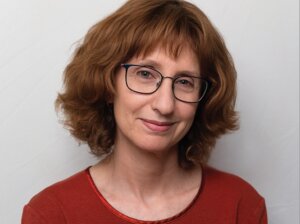As popularity of Yiddish skyrockets, Knesset launches Yiddish initiative in Israel

Graphic by Angelie Zaslavsky
Read this article in Yiddish
This week, a lobby was launched in the Knesset, urging the government to take responsibility for preserving Yiddish as a national language, and ultimately, for Israel to become the world center for Yiddish activity.
A Knesset lobby is a group of Knesset members who want to enlist support for individuals or a policy, among their colleagues and/or other government officials.
The group is being led by MK Tali Ploskov of the Likud party and is the brainchild of Dr. Ber Kotlerman, professor of Yiddish studies at Bar Ilan University.
At the task force’s first meeting, held in Shprintzak Hall in the Knesset building on November 3, Ploskov, a former deputy speaker of the Knesset, was accompanied by fellow MK Uzi Dayan (Likud), a retired major general of the Israel Defense Forces and nephew of the late military leader, Moshe Dayan.
Both Ploskov and Dayan said that the Yiddish language was close to their hearts, and shared childhood memories of their parents and grandparents speaking it.
Present at the meeting, besides Kotlerman, was Shmuel Atzmon, the founder of the Tel-Aviv Yiddish theater, “Yiddishpiel”.
Also participating, via Zoom, were representatives of Yiddish institutional life from four continents: Dr. Abraham Lichtenbaum, director of the YIVO Institute for Jewish Research in Buenos Aires; Jean Hessel, Yiddish advisor to the Language Council of Sweden; Dr. Gilhad Zuckerman, Chair of Endangered Languages at the University of Adelaide, Australia and myself, representing the American Yiddishist community.
In his introduction, Kotlerman declared that the Israeli government should be doing more to support the Yiddish language and culture, using the European Charter for Regional and Minority Languages – a treaty signed in 1992 to protect and promote historical regional and minority languages in Europe – as an example to emulate.
That charter, which includes Yiddish as one of its languages, was ratified by the Netherlands, Romania, Poland, Bosnia-Herzegovina and notably Sweden, which has done more than all the others to support Yiddish-language initiatives, including publishing children‘s books and producing cartoons and music videos in Yiddish.
“My goal is for Israel to help raise the status of Yiddish as a national language, the way Sweden has done for it as an official minority language,” Kotlerman said. “That would mean partnering with Yiddish institutions round the globe and eventually becoming a global center of Yiddishist activity.”
Jean Hessel explained how Sweden supports Yiddish and the other official minority languages, by providing financial assistance, advice, glossaries and by giving the members of the language community the right to have their children educated in their ancestral mother tongue.
As a way of conveying the need for public Israeli support of the Yiddish language and culture, Kotlerman and Atzmon chose a Yiddish translation of a poem by Israeli poet Haim Hefer, which Atzmon read aloud to the group. The poem, Beyad halashon [Through This Language], begins as a lament about Hitler’s unspeakable crimes, but transitions to an outcry against God and finally, a confession for the sins that many Israeli institutions and individuals carried out against the language and culture of their East European ancestors:
“And what about us? How we mocked and belittled her,
How we, either willingly or unwillingly, suppressed her loveliness and sealed up her mouth
How we, amid our hollow pride and snobbery, Sabra-style
Demanded that even memorial plaques be inscribed in Hebrew.”
Each participant was asked to say a few words. Atzmon expressed his joy in witnessing, after so many years, a growing interest among members of the Knesset in promoting Yiddish culture, adding: “Az me lebt, derlebt men!” – if you live long enough, you may live to see your dream realized. Avrom Lichtenbaum praised the Knesset for taking up a cause that has meant so much to Yiddish cultural activitsts round the world. He closed his remarks by tearfully reciting the Shehecheyanu blessing, the Jewish prayer said when celebrating a new experience or special occasion.
I then spoke to the committee, describing the rapidly growing popularity of Yiddish classes in the American Jewish community, as evidenced by the Workers Circle courses which now attract almost 1,000 students a year, as well as the daily Forverts YouTube series, “Yiddish Word of the Day” which, since its launch in April, has been viewed 350,000 times. Since so many people are seeking ways to connect to the Yiddish language, it’s essential that the Israeli government support Yiddish-language initiatives, not only in Israel, but in the diaspora as well.
After the meeting, Atzmon remarked that although a government agency for Yiddish was indeed set up years ago, it serves only Israelis.
“Think about it – Yad Vashem isn’t an institution just for people who live in Israel, but for everyone,” he said. “An Israeli Yiddish agency needs to be like the Yad Vashem for Yiddish literature throughout the world.”























